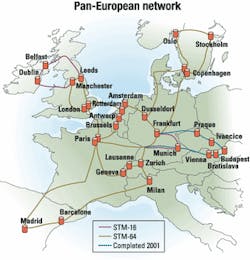BT Ignite pushes fiber across Central and Eastern Europe
By EDWARD HARROFF
At the end of 2001, BT Ignite completed phase three of Europe's largest network footprint. Ignite has combined some inherited assets from past BT-funded joint ventures across the continent into this build project and now boosts its pan-European communications fiber network to 55,000 route-km, connecting 275 cities and equipped with 20 content-hosting hubs.
The BT Ignite network connects customers in Austria, the Czech Republic, Slovakia, and Hungary. The phase three build project used two STM-64 rings linking key cities in the backbone network: Frankfurt, Munich, Vienna, Prague, Budapest, and Bratislava (see Figure).
This network project was awarded to Nortel Networks, which was one of five suppliers that completed BT's bidding procedures. Nortel has a longstanding relationship with BT, but these Eastern European rings represent another major commercial win for SDH-based technology systems (in this case, the Nortel Optera DX platform) that are wavelength-ready for future needs. Through the deployment of Nortel's SDH and DWDM technology, the network will be optimized for the transmission of IP traffic at 160 Gbits/sec, with the capability to increase transmission to 320 Gbits/sec in the future. The whole network will be fully managed by Nortel's Integrated Network Management platform.
"We are delighted to offer immediate connectivity to many of our major customers into Central and Eastern Europe," says Steve Andrews, BT Ignite's president of carriers, networks, and systems. "The evolution of the European market makes this a natural extension to our capability and further demonstrates Ignite's commitment to meet the connectivity demands of existing and new customers.""This is a very hot area," adds Colin Hopkins, director of BT Ignite carrier networks. Three of the four newly connected countries are bidding to join the European Union (EU), and Hopkins notes that "to get an economic return at this point and be positioned as they trade more and more with the EU, is a huge opportunity. Ignite has already sold capacity on the new routes." The company expects most demand to come from corporate customers, primarily out of Germany. "[There has been] huge interest from the carrier community, but our focus is making sure we serve those corporates," he explains. Ignite has sales and service capability in Vienna, Prague, Budapest, and Bratislava.
However, the timing of this network expansion in Eastern Europe has not really impressed analysts that follow BT's recent restructuring. Rob Pritchard, director at benchmark-it.co.uk Ltd. (a telecommunications research group based in the United Kingdom), has given BT Ignite a current profile of "wait and see" since many channel issues need to be resolved in several countries and the former Concert portfolio must be successfully blended. As part of the restructuring, BT Ignite is now responsible for international and corporate data services.
"What a difference one year makes in the alternate pan-European carriers business," observes Pritchard. "Following last year's demise of the BT-AT&T Concert joint venture, the European assets of Concert have been entrusted to the BT Ignite group. BT Ignite has got to come to grips with its new assets, develop a coherent and implemental strategy, and get moving. In many ways, it has the advantage of being able to reorganize and refocus when the industry as a whole is in turmoil. It appears to have many of the components required to compete-a solid portfolio of voice, data, Internet, and hosting services-and continues to carry enough weight to strike partnerships with major players if required."
Another concern is the poor state of Germany's economy. The German unit of BT Ignite, which comprises the fixed and data activities of Viag Interkom and employs 1,500 people, is said to be struggling. Ignite as a whole reported a $230-million operating loss for the first half of 2001. "In light of that, we are looking to Ignite to reduce costs right across the business," says Pritchard.
The Financial Times quoted Ignite's Europe chief, Wolfgang Essig, as saying the German unit would be overhauled and several hundred jobs cut. Ignite's CEO position has also undergone change recently, when Alfred Mockett stepped down in November and was replaced by Andy Green (formerly at BT Openworld).
BT Ignite chose to add the four new countries to its own network partly to lower the cost base and partly to serve its existing customers in the region, according to Andrews. Ignite claims to have almost 1,000 corporate customers there already. "Further expansion will be very selective," he says. "If we extend, it will be on a case-by-case and link-by-link basis."
Adds Andrews, "The integration of the old Concert business is proceeding on track." With BT and former partner AT&T unwinding their Concert joint venture, BT Ignite will get the Concert managed services infrastructure in EMEA [Europe, the Middle East, and Africa], which Andrews sees as "a huge opportunity for Ignite and for BT."
REPRINTS
For information, contact
Kathleen McIntosh at
603-891-9203, fax 603-891-0587,
or e-mail: [email protected].

